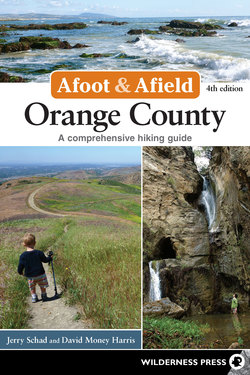Читать книгу Afoot and Afield: Orange County - Jerry Schad - Страница 15
На сайте Литреса книга снята с продажи.
Оглавлениеtrip 1.1 Bolsa Chica Ecological Reserve
Distance 1.6-plus miles (loop)
Hiking Time 1 hour
Elevation Gain Negligible
Difficulty Easy
Trail Use Good for kids
Best Times All year
Agency BCER
DIRECTIONS The trailhead lies on the inland side of the Pacific Coast Highway (Highway 1), 1.5 miles south of Warner Avenue, and 1.5 miles north of Seapoint Avenue in Huntington Beach.
The Bolsa Chica Ecological Reserve protects the largest saltwater marsh between Monterey Bay and the Tijuana River. Its name, Spanish for “little purse,” came from a subdivided portion of an 1834 Mexican land grant. The wetlands were dammed to create a duck hunting preserve around 1895, and then they were built up for oil drilling in 1940 and for a coastal defense artillery battery during World War II. Since 1973, California has recognized the ecological significance of the wetlands and has been restoring them. In 2006, a major project was completed to remove the dam and much of the oil equipment. Birds and fish are now flourishing, making it a very popular destination for wildlife observation.
This hike makes a loop around Bolsa Chica Slough. Binoculars, spotting scopes, and/or cameras are de rigueur, of course.
First, consider paying a visit to the Bolsa Chica Interpretive Center on Warner Avenue at the Pacific Coast Highway. Visitors can also get a checklist of local birds and information about the reserve there. You could also start your hike from there, if you’d like.
From the parking lot on the PCH, a long, wooden bridge leads over some shallow stretches of tide water invaded by typical saltwater marsh plants: cordgrass, alkali heath, sea lavender, and pickleweed. Interpretive panels tell of two endangered species of birds that frequent this area: the least tern, which nests on two small, sandy islands nearby; and the Belding’s savannah sparrow, a bird that can drink seawater, processing it with its hyperefficient kidneys. Early on weekend mornings, photographers use the bridge as a stable platform for their often sophisticated equipment.
On the far side of the bridge, a path goes left atop a levee, eventually encircling a segment of the slough. On the surface and the shoreline, you may spot gulls, terns, egrets, cormorants, pelicans, stilts, plovers, avocets, grebes, marsh hawks, herons, and kites. The number and diversity of birds vary with the season.
At 0.9 mile, pass the Wintersburg Channel, and then walk up to a scenic viewpoint on the lip of a nearby mesalike terrace. Gabrieleno Indians contemplated a lonely scene here centuries ago. They beheld a broad, shallow bay extending well inland, rimmed by saltwater and freshwater marshes as far as the eye could see. Later, two 155-millimeter guns were mounted here to defend Southern California’s coastline during World War II.
From this viewpoint, you can add an optional 0.8-mile loop northwest to visit the Bolsa Pocket Wetlands. The Pocket Loop Trail begins along the ridge but soon splits. Make a counterclockwise loop, dropping down along the edge of the wetlands for more birding opportunities. Come back up on the ridge for views of Catalina Island beyond the oil platforms in the channel. Listen for birds nesting in the eucalyptus trees nearby.
Bolsa Chica
Whether you take the pocket wetlands loop or not, the most expedient way to return is to head south across the levee and follow a mostly paved path back along the side of the Pacific Coast Highway. You can enjoy another set of views of the birds from this path. However, you’ll have to endure the highway noise, so some people will prefer to retrace their steps along the quieter route by which you came.
